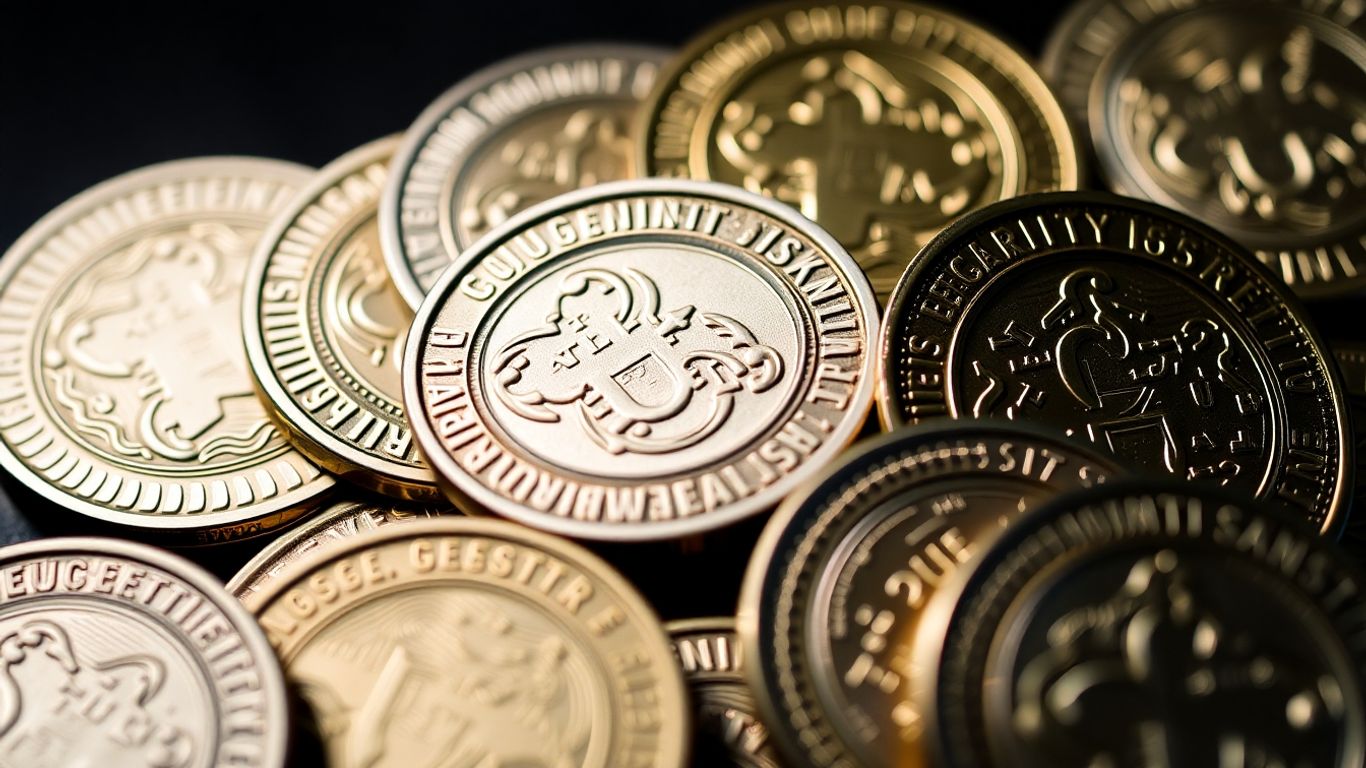So, you've heard about security tokens, right? They're kind of like digital versions of traditional investments, like stocks or bonds, but they live on the blockchain. This whole setup relies heavily on something called security token standards. Think of them as the rulebooks that make sure these digital assets can actually work together and be trusted. Without them, things would be a mess, and nobody would be able to trade or manage these tokens properly. This article is going to break down what these standards are all about.
Key Takeaways
- Security tokens are digital representations of real-world assets and need specific rules, called standards, to function correctly on blockchains.
- Basic standards like ERC-20 are good for simple tokens but don't have the features needed for the strict requirements of security tokens.
- Newer standards, such as ERC-1400 and ERC-1404, are designed specifically for security tokens, adding features for compliance and restrictions.
- Standards like ERC-1155 allow for managing different types of tokens, including non-fungible ones, all within a single system.
- Choosing the right security token standard depends on what your project needs, considering things like compatibility, legal rules, and how complex you want it to be.
Understanding Security Token Standards

The Importance of Token Standards
Think about building with LEGOs. You can snap different bricks together because they're all made to a standard size and shape, right? Token standards on the blockchain work kind of like that. They provide a common blueprint so that different tokens can interact with each other and with various applications, like wallets and exchanges, without a hitch. Without these standards, every new token would be like a custom-shaped LEGO brick – you'd need special tools and lots of extra work just to make it fit anywhere. This makes development way faster and helps more people actually use the tokens.
Defining Security Tokens
So, what exactly is a security token? Basically, it's a digital token that represents ownership in an asset, much like a stock or a bond. This asset could be anything from a piece of real estate, a share in a company, or even rights to future profits. Because they're tied to real-world assets and often represent an investment, security tokens are treated like traditional securities. This means they come with a whole set of rules and regulations, like needing to know who's buying them (Know Your Customer, or KYC) and preventing money laundering. These rules are a big deal and affect how these tokens can be bought, sold, and transferred.
Key Differences from Utility Tokens
It's easy to get security tokens mixed up with utility tokens, but they're quite different. Utility tokens are usually designed to give you access to a product or service within a specific network or platform. Think of them like a token for a video game or a subscription to a service. They don't typically represent ownership or an investment in the company itself. The main difference boils down to regulation and purpose: security tokens are regulated investments, while utility tokens are for accessing a service.
Here's a quick rundown:
- Security Tokens: Represent ownership, rights to profits, or other financial interests. They are regulated like traditional securities (stocks, bonds).
- Utility Tokens: Grant access to a product or service on a specific platform. They are generally not regulated as investments.
This distinction is super important because the regulatory requirements for security tokens mean they need special features built into their underlying code, features that utility tokens usually don't need.
Foundational Security Token Standards
When we talk about security tokens, it's easy to get lost in the fancy new standards, but it's important to remember where we started. Many of these newer, more specialized tokens build upon the groundwork laid by earlier, more general-purpose standards. Understanding these foundational pieces helps us appreciate the evolution and the specific needs that drove the development of security token-specific protocols.
The ERC-20 Standard and Its Limitations
The ERC-20 standard is probably the most well-known token standard on the Ethereum blockchain. It laid out a common set of rules for creating fungible tokens, meaning each token is identical and interchangeable, like a dollar bill. Think of it as the blueprint for creating digital versions of currencies or commodities. It defines functions like transferring tokens, checking balances, and approving spending by other addresses. This standardization was a big deal because it meant that wallets, exchanges, and other applications could easily support any ERC-20 token without needing custom code for each one. This made tokens much more accessible and tradable.
However, ERC-20 was designed for a wide range of tokens, not specifically for security tokens. Security tokens, by their nature, often need to comply with strict regulations. This means things like knowing who owns the tokens (KYC/AML), restricting who can buy or sell them, and sometimes even forcing transfers back to the issuer under certain conditions. ERC-20 just doesn't have these built-in features. It's like trying to use a basic hammer for a job that requires a specialized power tool – it might do something, but it's not ideal and often impossible to meet all the requirements.
The simplicity of ERC-20, while great for broad adoption, means it lacks the specific controls needed for regulated assets. This gap is where the need for more specialized standards becomes apparent.
Evolution with ERC-223 and ERC-777
Recognizing the limitations of ERC-20, developers proposed improvements. ERC-223, for instance, aimed to prevent accidental token loss by adding a tokenFallback function. This meant that when tokens were sent to a contract, the contract could actually receive them properly, rather than the tokens just getting lost forever. It was a step towards making token transfers safer.
Then came ERC-777. This standard built upon ERC-20 and ERC-223, offering more flexibility. It introduced features like operator tokens, which allow a third party to manage tokens on behalf of the owner, and a way to send tokens with data attached. This was useful for things like sending notifications along with a token transfer. While these were improvements, they still didn't fully address the complex regulatory needs of security tokens. They were more about making fungible token transfers safer and more flexible, not about enforcing legal compliance.
The Role of ERC-721 for Non-Fungible Assets
While ERC-20 deals with fungible tokens (like shares of stock), not all security tokens are fungible. Some represent unique assets, like a piece of art, a specific property, or a unique collectible. For these, the ERC-721 standard became the go-to. ERC-721 defines how to create non-fungible tokens (NFTs), where each token is unique and cannot be replaced by another. Each token has a unique ID, making it distinct from all others.
This standard is important for security tokens because it allows for the tokenization of unique, high-value assets. Imagine a security token representing ownership of a specific building or a rare piece of intellectual property. ERC-721 provides the framework for this kind of unique asset representation on the blockchain. However, like ERC-20, ERC-721 itself doesn't include the specific compliance features required for regulated securities. It handles the uniqueness but not the regulatory overlay that security tokens demand. The development of standards like ERC-7518 shows the ongoing effort to build more robust solutions.
Specialized Standards for Security Tokens
Introducing ERC-1400: A Comprehensive Approach
When we talk about security tokens, we're dealing with digital assets that represent ownership in something real, like company shares or real estate. Because of this, they have to play by a lot of rules, much like traditional stocks or bonds. The basic ERC-20 standard, while great for many things, just doesn't have the built-in features needed to handle these regulations. That's where specialized standards come in. ERC-1400 is one of these, aiming to be a more complete solution for security tokens. It bundles together various functionalities that are pretty important for compliance. Think of it as a toolkit designed specifically for the complexities of regulated assets.
ERC-1404: Streamlining Compliance with Restrictions
Another standard trying to make things easier is ERC-1404. This one is built on top of ERC-20, so it keeps a lot of that familiar structure. Its main goal is to add specific rules for transferring tokens. For example, it can help set up whitelists, meaning only approved people or entities can hold or trade the tokens. It also allows for clear messages if a transfer doesn't go through, which is helpful for debugging and user understanding. It's designed to be simpler to implement than something like ERC-1400, but it does have a limitation: once the rules are set, they can't be easily changed later on.
ST-20: Building on ERC-20 for Regulated Tokens
ST-20 is another approach that takes the widely used ERC-20 standard and adds specific features for security tokens. The idea here is to make it easier for existing systems that already support ERC-20 to also support these regulated tokens. ST-20 allows issuers to add controls over token transfers, making sure they align with legal requirements. It's like adding a layer of compliance on top of a well-known foundation. This can be a good middle ground, offering more control than a plain ERC-20 token without the full complexity of some other standards.
The need for specialized standards arises because security tokens are treated like traditional financial securities. This means they must adhere to regulations like Know Your Customer (KYC) and Anti-Money Laundering (AML) rules. These regulations often restrict who can hold or trade the tokens, requiring features that basic token standards don't provide.
Here's a quick look at how some of these specialized standards compare:
These standards are still evolving, and their adoption depends on how well they meet the practical needs of issuers and investors in the regulated digital asset space.
Advanced Security Token Functionality
ERC-1155: Managing Multiple Token Types
Think about a game where you have different kinds of items. Some are common, like gold coins you collect a lot of (fungible), while others are unique swords or rare artifacts (non-fungible). Trying to manage all these different types of items using separate standards can get messy and expensive, especially when it comes to transaction fees on the blockchain. That's where ERC-1155 comes in. It's a pretty neat standard because it lets you handle multiple token types – fungible, semi-fungible, and non-fungible – all within a single smart contract. This means you can send a batch of gold coins and a unique sword in the same transaction, which is way more efficient. It's still a bit of a work in progress, but it's already showing up in a lot of digital gaming projects.
Programmable Compliance Features
One of the biggest headaches with traditional securities is making sure everyone follows the rules. It often involves a lot of paperwork and manual checks. Security tokens, however, can have these rules built right into their code. This means things like:
- Investor Eligibility: The token can automatically check if the person trying to buy or receive it is allowed to, based on things like their location or whether they've passed Know Your Customer (KYC) checks.
- Holding Periods: If there's a rule that an investor has to hold onto a token for a certain amount of time (like a lock-up period), the smart contract can enforce this.
- Transfer Restrictions: The token can be programmed to only allow transfers between specific, approved addresses or to prevent transfers to certain jurisdictions.
This "compliance by design" approach means that the rules are enforced automatically, reducing the risk of human error and making things much smoother for issuers and investors alike. It’s a big step up from how things worked before, making digital assets more reliable and easier to manage within regulatory frameworks. This ability to automate compliance is a key reason why security tokens are gaining traction in regulated markets.
Whitelisting and Transfer Restrictions
Beyond the general programmable compliance, specific standards focus on making sure only the right people can interact with the tokens. Whitelisting is a prime example. Imagine you're issuing shares in a company. You don't want just anyone buying them; you want to ensure they meet certain criteria, like being an accredited investor or being based in a specific region. A whitelist, managed by the token's smart contract, acts like a guest list. Only addresses on that list are permitted to receive or send the tokens. This is often implemented through extensions of existing standards, like ERC-1404, which can also provide human-readable messages if a transfer is blocked, making it clearer why something didn't go through. It’s a way to add layers of control that are directly tied to the token itself, rather than relying solely on external platforms or manual processes. This makes the entire process more transparent and secure for all parties involved.
The ability to hard-code restrictions directly into a security token's smart contract is a game-changer. It means that compliance isn't just a suggestion; it's an enforced part of the token's lifecycle, from issuance to potential secondary market trading. This automation significantly reduces the operational burden and the risk of regulatory breaches that have plagued traditional finance for decades.
Navigating the Security Token Landscape

Interoperability and Compatibility Considerations
So, you've got your security tokens all set up, maybe using ERC-1400 or ST-20. That's great, but what happens next? You can't just have tokens sitting in a digital void. They need to talk to other systems, right? Think about how your tokens will interact with digital wallets – both the ones you control and the ones that a custodian manages for you. Then there's the whole identity piece. How will you link your tokens to verified investors? This often involves working with KYC/AML providers, maybe through special identity tokens or just attestations. And for trading, you'll need to connect with regulated secondary markets, like those special Alternative Trading Systems (ATS) or Multilateral Trading Facilities (MTF) that are built for this stuff. Don't forget about the systems that handle custody and fund administration; your tokens need to play nice with them too. It's all about making sure your security tokens can plug into the broader digital finance ecosystem, like digital payment rails for getting dividends or interest out. Basically, they need to be ready for the modular finance future.
Choosing the Right Standard for Your Project
Picking the right token standard is kind of like choosing the right tool for a job. You wouldn't use a hammer to screw in a bolt, would you? For security tokens, it's similar. If you're dealing with simple, fungible assets like shares in a company, something like ST-20, which builds on the familiar ERC-20, might be a good starting point. It's designed with regulated tokens in mind. But if you need more complex features, like built-in compliance rules that restrict who can hold or transfer the token, then ERC-1400 or ERC-1404 could be a better fit. These standards bake compliance right into the token itself. And if your project involves different types of assets, maybe both equity and debt, or even different classes of shares, then ERC-1155, which can handle multiple token types, might be the way to go. It really boils down to what your specific needs are regarding compliance, asset type, and how you want investors to interact with your tokens.
The Future of Security Token Standards
It's still pretty early days for security tokens, and the standards are evolving. We're seeing a big push towards making these tokens more programmable, so things like dividend payments or voting rights can happen automatically through smart contracts. This cuts down on a lot of manual work and potential errors. The goal is to have compliance built directly into the token, making it easier for everyone involved to follow the rules. We're also looking at how identity can be managed more effectively on-chain, so that only the right people can hold or trade certain tokens. Think about automated whitelisting or transfer restrictions that work in real-time. As more institutions get involved, the demand for robust, secure, and interoperable standards will only grow. We'll likely see further refinement of existing standards and maybe even new ones emerge to handle specific use cases, like tokenizing complex derivatives or managing carbon credits with built-in ESG reporting.
Wrapping It Up
So, we've looked at a bunch of different token standards out there, especially the ones designed for security tokens. It's clear that while ERC20 is super common and works for a lot of things, it just doesn't cut it when you need to follow all the strict rules for security tokens. That's why folks have come up with newer standards, like extensions to ERC20 or more complex ones, to handle things like who can trade them and making sure everything stays legal. Ultimately, picking the right standard really depends on what your project needs to do, where it's operating, and how complicated you want to get. It's a bit of a puzzle, but getting it right is key for making sure your security tokens work the way they're supposed to.
Frequently Asked Questions
What exactly is a security token?
Think of a security token as a digital version of traditional investments like stocks or bonds. It represents ownership in something valuable, like a company's shares or real estate, and its value comes from that underlying asset. Because it's like a traditional investment, it has to follow specific rules and laws.
Why are token standards important for security tokens?
Token standards are like a common language for digital tokens. For security tokens, standards ensure they can be easily used with different digital wallets and trading platforms. They also help make sure the tokens follow important legal rules, like knowing who is buying them, which is crucial for regulated assets.
How is a security token different from a utility token?
A utility token is mainly used to access a service or product within a specific digital system, like a game or an app. A security token, however, represents an investment in an asset and is treated like a traditional security, meaning it's subject to financial regulations.
What does ERC-20 have to do with security tokens?
ERC-20 is a very popular standard for basic digital tokens, but it wasn't originally designed for security tokens. While many security tokens try to be compatible with ERC-20 for easy trading, it lacks the special features needed to follow all the rules required for investments, like restricting who can buy or sell them.
Are there special standards just for security tokens?
Yes, there are! Standards like ERC-1400 and ERC-1404 were created specifically for security tokens. They add features that help enforce legal requirements, such as controlling who can own the tokens or adding extra information to transactions to prove compliance.
What are some challenges when using security token standards?
One big challenge is making sure different standards can work together smoothly. Also, many of the newer, more specialized security token standards are still being developed, so they might change. Choosing the right standard depends on what your project needs to do and the specific laws in the places you operate.




